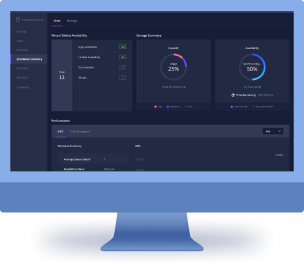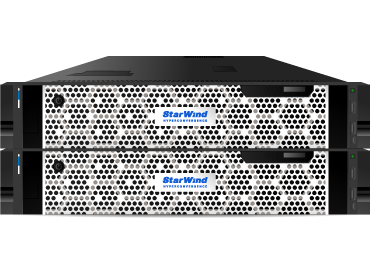The Definitive Guide on How to Build Your Perfect HCI
Hyperconverged infrastructure (HCI) combines compute, storage, and networking resources in a single “building block” and adopts the Software-Defined Everything approach.
The Software-Defined Storage (SDS) stack eliminates need for the proprietary storage hardware, significantly reducing costs since dedicated storage hardware is no longer needed. The storage is controlled at the OS or Hypervisor layer with the help of virtual storage controllers. These virtual controllers run on every node within the cluster ensuring unified storage management, better resiliency, and failover capabilities.
Software-Defined Networking (SDN) makes network management agile and flexible by providing a centralized interface allowing administrators to manage traffic and quickly distribute network resources where they are needed.
Such integrated technologies dramatically improve IT infrastructure efficiency by automating provisioning and configuration of the entire networking stack.

Hyperconverged infrastructure unifies the datacenter stack elements, namely, storage, networking, compute, and associated software, like hypervisor, into an abstracted layer of available IT resources.
HCI converges datacenter server hardware with direct-attached storage media (HDDs, SSDs, NVMe) by using virtualization. The virtualized resources become a single pool which can then be distributed as needed thanks to the relevant software.
This way, HCI resolves the common issues of typical converged infrastructure: you can build HCI from any commodity hardware, you can scale freely, you can have high performance and disaster resistance with what you already got, and every bit of your underlying hardware potential is put to good use, without any leaks, overhead, hiccups, and bottlenecks.
There is a lot to take in when it comes to hyperconverged infrastructure. Like always, people like to pit concepts against each other, however, software and hardware HCI are two distinct approaches rather than alternatives.
| Hardware HCI | Software HCI | |
| Form | Hardware platform (appliance) | Software solution |
| Intention | Storage-to-CPU ratio optimization based on business and IT infrastructure needs (balanced, performance-focused, capacity-focused, etc.) | Hardware resources virtualization for further distribution, capitalization, and optimal use (performance, resiliency, backup, etc.) |
| Utilization | Deployed as is, ready-to-work data center in a compact form | Software deployment, virtualizes storage, server, or networking |
| General Benefit | Great for high-intensity workload IT environments and when high hardware modularity and scalability are of the essence | Allows to gain HCI benefits and perks on available commodity hardware without buying a new appliance |
| General Concern | Appliances tend to be proprietary to the HCI vendor, scalability can boil down to adding an entire new HCI node instead of granular scaling, vendor lock-in possible | Existing hardware won’t be as intentionally picked and tightly integrated as in hardware HCI, may need other software for monitoring and management |

98% of StarWind customers would definitely recommend it to other businesses based on G2’s Summer 2023 Grid® Report for HCI Solutions

in Gartner® Peer Insights: "Voice of the Customer": Hyperconverged Infrastructure

The main idea of converged infrastructure (CI) is to minimize compatibility issues between servers, storage systems, and network switching. To achieve this, a converged infrastructure delivers a set of separate compute, storage, and networking resources optimized and tested for better interoperability. While reducing the complexity of the data center IT infrastructure to a certain extent, a converged approach has significant drawbacks.
The components in a converged infrastructure are managed separately, requiring dedicated applications to manage various pieces of hardware, sometimes making administration a challenging task.
Furthermore, such infrastructures have a large hardware footprint – servers, data storage devices, and networking equipment occupy unnecessary space and convert into limited flexibility and scaling options. Additionally, due to a large amount of hardware utilized, CI implies significant deployment and operational expenses.
Unlike other vendors, we’re not saying that converged infrastructure is “legacy” and that hyperconvergence is the only way. Each scenario has its use cases and benefits. HCI brings significantly reduced hardware footprint, infrastructure and environment simplicity, reduced IT resources and IT management costs, as well as visibly increased ROI.
StarWind HCI Appliance includes user-tailored configuration, free assisted migration, and dedicated ProActive Support engineers to “babysit” your HCI 24/7/365.
StarWind HCI Appliance is the only offer on the market that brings all of modern hyperconvergence features and benefits in a tiny 2-node footprint.
HCI is inspired by and tailored perfectly for ROBO, Edge, and VDI scenarios with its deployment, operation, and maintenance simplicity with StarWind having your back round-the-clock remotely.
StarWind HCI is configured to your requirements, has zero hardware restrictions, and boasts a unique all-flash blend for best longevity, energy consumption, capacity, and performance.
Today, the complexity of data center IT environment is continuously growing as the amount of data increases and applications demand more compute power with more infrastructure components needed to support it.
At the same time, IT departments should always be able to provision resources instantly while maintaining flexibility and scalability of the infrastructure to handle unpredictable data growth.
Traditional data center infrastructure is comprised of separate compute, storage, and networking components requiring different administrative groups and systems for their management. The storage team, for example, handles the maintenance of the storage subsystem and the relationship with the storage hardware vendor. The same goes for the servers and the network teams.
Such infrastructures feature multiple management interfaces for separate components, higher maintenance costs, and are a real headache in terms of support since different components often come from different vendors.
All of this makes infrastructure management a highly time- and effort-consuming task forcing businesses to spend their time and money just on keeping the IT infrastructure working instead of focusing on innovations and services delivery.
StarWind has been bringing enterprise-quality storage virtualization and hyperconvergence benefits in minimalistic form to the average business for well over a decade. We don’t believe in gatekeeping and don’t practice vendor lock-in. Hyperconverged infrastructure solutions from StarWind are built to deliver white-glove HCI experience at reasonable price and minimum effort.


There are various misconceptions about hyperconverged infrastructure (HCI) from unfriendly scalability conditions and complex operability to unjustified costs and overkill requirements.
There is some truth to some of them. However, it depends on which HCI vendor you’re looking at, what your business really needs, and how best you should approach your mission-critical applications.
Under the Hood of StarWind All-Flash HyperConverged Appliance
StarWind VSAN for Hyper-V on VMware vSphere 6.5. ESXi Hosts
StarWind VSAN HCI for a 3-Node Windows Server 2016 Scenario
How VMware VSAN Really Performs by Using the HCIBench Utility
Where Microsoft Is Going with Its Innovations for Azure Stack HCI
Our products are now available at flexible subscription payments simply as part of your OpEx.